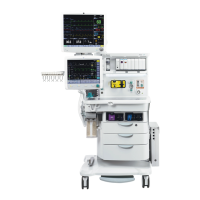Gas supplies
Pressurized gas supplies enter the system through a pipeline or
cylinder connection. All connections have indexed fittings, filters, and
check valves.
A regulator decreases the cylinder pressures to the appropriate
system pressure. A pressure relief valve helps protect the system
from excessive high pressures.
To help prevent problems with the gas supplies:
•
Install yoke plugs on all empty cylinder connections.
• When a pipeline supply is connected, keep the cylinder valve
closed.
• Disconnect the pipeline supplies when the system is not in use.
Do not leave gas cylinder valves open if the pipeline
supply is in use. Cylinder supplies could be depleted,
leaving an insufficient reserve supply in case of pipeline
failure.
O2 flow
Pipeline or regulated cylinder pressure supplies O2 directly to the O2
channel of the gas mixer and to the ventilator if O2 is configured as
drive gas. If the pressure is too low, an alarm appears on the display.
A second regulator decreases the pressure for the flush valve and
the auxiliary O2 flowmeter.
The flush valve supplies high flows (between 25 and 75 l/min) of O2
to the fresh gas outlet when the O2 flush button is pushed. The flush
switch uses pressure changes to monitor the position of the flush
valve.
Air and N2O
Pipeline or regulated cylinder pressure supplies Air directly to the air
channel of the gas mixer and to the ventilator if Air is configured as
drive gas. If the pressure is too low, an alarm appears on the display.
Pipeline or regulated cylinder pressure supplies N2O directly to the
N2O channel of the gas mixer. If the pressure is too low, an alarm
appears on the display.
WARNING
Aisys CS²
11-4 2067226-001

